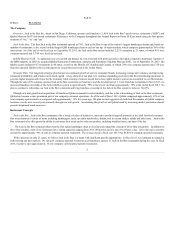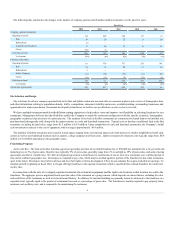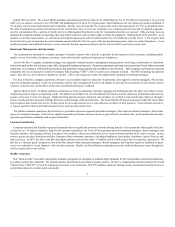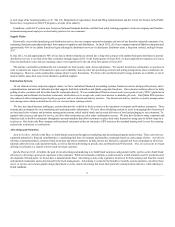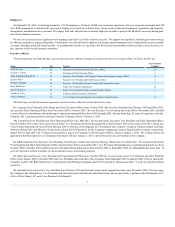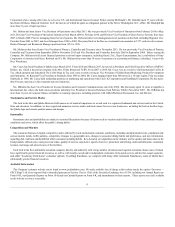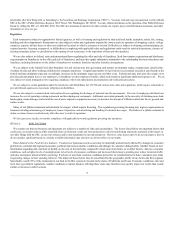Jack In The Box 2013 Annual Report Download - page 14
Download and view the complete annual report
Please find page 14 of the 2013 Jack In The Box annual report below. You can navigate through the pages in the report by either clicking on the pages listed below, or by using the keyword search tool below to find specific information within the annual report.
will have the business abilities or sufficient access to financial resources necessary to open the restaurants required by their agreements, or prove to be effective
operators and remain aligned with us on operations, promotional or capital-intensive initiatives.
Our franchisees are contractually obligated to operate their restaurants in accordance with all applicable laws and regulations, as well as standards set forth
in our agreements with them. However, franchisees are independent third parties whom we cannot and do not control. If franchisees do not successfully operate
restaurants in a manner consistent with applicable laws and required standards, royalty, and in some cases rent, payments to us may be adversely affected. If
customers have negative perceptions or experiences with operational execution, food quality or safety at our franchised locations, our brands’ image and
reputation could be harmed, which in turn could negatively impact our business and operating results.
With an increase in the proportion of Jack in the Box franchised restaurants, the percentage of our revenues derived from royalties and rents at Jack in the
Box franchise restaurants will increase, as will the risk that earnings could be negatively impacted by defaults in the payment of royalties and rents. As small
businesses, some of our franchise operators, may be negatively and disproportionately impacted by strategic initiatives, capital requirements, inflation, labor
costs, employee relations issues or other causes. In addition, franchisee business obligations may not be limited to the operation of Jack in the Box or Qdoba
restaurants, making them subject to business and financial risks unrelated to the operation of our restaurants. These unrelated risks could adversely affect a
franchisee’s ability to make payments to us or to make payments on a timely basis. We cannot assure that franchisees will successfully participate in our
strategic initiatives or operate their restaurants in a manner consistent with our concepts and standards. As compared to some of our competitors, our Jack in
the Box brand has relatively fewer franchisees who, on average, operate more restaurants per franchisee. There are significant risks to our business if a
franchisee, particularly one who operates a large number of restaurants, encounters financial difficulties or fails to adhere to our standards and projects an
image inconsistent with our brands.
Risk Relating to Competition, Menu Innovation and Successful Execution of our Operational Strategies and Initiatives. We are focused on increasing
same-store sales and average unit volumes as part of our long-term business plan. These results are subject to a number of risks and uncertainties, including
risks related to competition, menu innovation and the successful execution of our operational strategies and initiatives. The restaurant industry is highly
competitive with respect to price, service, location, personnel, advertising, brand identification and the type, quality and innovativeness of menu items and
new and differentiated service offerings There are many well-established competitors. Each of our restaurants competes directly and indirectly with a large
number of national and regional restaurant chains, as well as with locally-owned and/or independent quick-service restaurants, fast-casual restaurants, casual
dining restaurants, sandwich shops and similar types of businesses. The trend toward convergence in grocery, deli and restaurant services may increase the
number of our competitors. Such increased competition could decrease the demand for our products and negatively affect our sales and profitability. Some of
our competitors have substantially greater financial, marketing, operating and other resources than we have, which may give them a competitive advantage.
Certain of our competitors have introduced a variety of new products and service offerings and engaged in substantial price discounting in the past, and may
adopt similar strategies in the future. In an effort to increase same-store sales, we continue to make improvements to our facilities, to implement new service
and training initiatives, and to introduce new products and discontinue other menu items. However, there can be no assurance that our facility improvements
will foster increases in sales and yield the desired return on investment, that our service initiatives or our overall strategies will be successful, that our menu
offerings and promotions will generate sufficient customer interest or acceptance to increase sales, or that competitive product offerings, pricing and
promotions will not have an adverse effect upon our margins, sales results and financial condition. In addition, the success of our strategy depends on, among
other factors, our ability to motivate restaurant personnel and franchisees to execute our initiatives and achieve sustained high service levels.
Advertising and Promotion Risks. Some of our competitors have greater financial resources, which enable them to purchase significantly more
advertising, particularly television and radio ads, than we are able to purchase. Should our competitors increase spending on advertising and promotion,
should the cost of advertising increase or our advertising funds decrease for any reason, including reduced sales or implementation of reduced spending
strategies, or should our advertising and promotion be less effective than our competitors, there could be a material adverse effect on our results of operations
and financial condition. Also, the fragmentation in the media favored by our target consumers, including growing prevalence and importance of social and
mobile media, poses challenges and risks for our marketing, advertising and promotional strategies. Failure to effectively tackle these challenges and risks
could also have a materially adverse effect on our results.
Taxes. Our income tax provision is sensitive to expected earnings and, as those expectations change, our income tax provisions may vary from quarter-to-
quarter and year-to-year. In addition, from time to time, we may take positions for filing our tax returns that differ from the treatment for financial reporting
purposes. The ultimate outcome of such positions could have an adverse impact on our effective tax rate.
Risks Related to Reducing Operating Costs . In recent years, we have identified strategies and taken steps to reduce operating costs to align with the
increased Jack in the Box franchise ownership and to further integrate Jack in the Box and Qdoba brands
12


